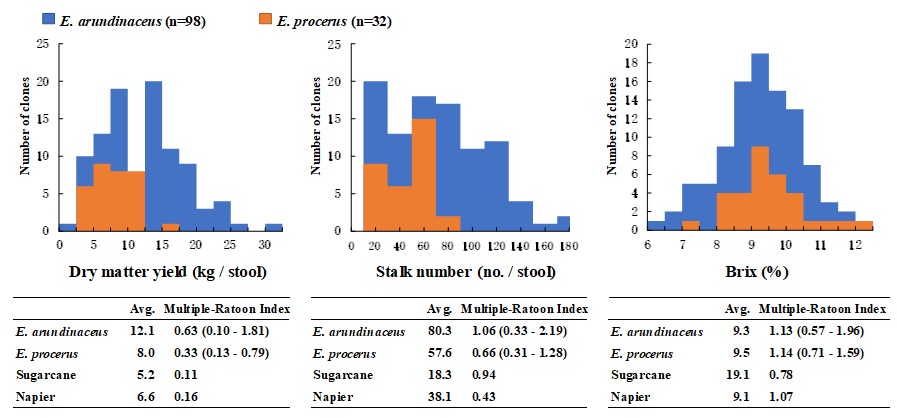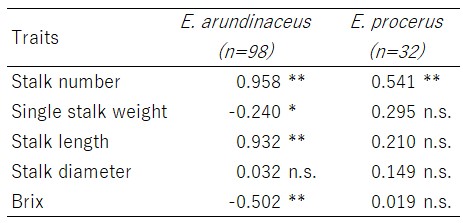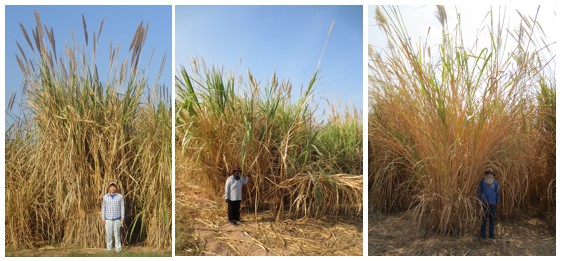Information on the genetic diversity in agronomic traits of Thai Erianthus germplasm under multiple ratooning systems
Description
Erianthus spp., one of the genetic resources of a closely related genus of sugarcane, show considerable potential as breeding material for sugarcane improvement and as a new biomass crop due to its high biomass productivity under multiple ratooning systems. Strong ratooning ability is a desirable trait not only because it is key to improving sugar and fiber production, but also because it avoids the need for frequent replanting, thus playing an important role in ensuring sustainable cultivation with lower production costs and energy input as well as in preventing soil erosion. However, the lack of scientific information on the genetic diversity of agronomic traits, especially under multiple ratooning systems, prevents us from the effective breeding use of this genetic resource. To utilize Erianthus for sugarcane breeding and biomass production effectively, JIRCAS and Khon Kaen Field Crops Research Center, Department of Agriculture, Thailand, collected E. arundinaceus and E. procerus germplasm from all over Thailand, which is presumed to host diverse Erianthus genetic resources due to its location between India, Indonesia, and China. In this study, we evaluated the genetic variation of important agronomic traits in Thai Erianthus germplasm in multiple ratooning systems as an initial screening of a large number of clones with diverse genetic backgrounds to obtain basic information and identify potentially valuable materials for breeding of sugarcane and new biomass crop in Thailand.
The 98 E. arundinaceus and 32 E. procerus clones collected in Thailand showed large genetic variation in agronomic traits related to biomass productivity under multiple ratooning systems, and many clones have higher dry matter yield than sugarcane variety and Napier grass (Fig. 1). There is also a large variation in Multiple-Ratoon Index (the ratio of 3rd ratoon to 1st ratoon), and many clones provided better dry matter yields and lower yield reductions in ratoon crops than a sugarcane cultivar, highlighting the importance of identifying and using clones as breeding materials with excellent dry matter yields and Multiple-Ratoon Index. Furthermore, the dry matter yield showed a strong genetic correlation with stalk number, but not with single stalk weight, stalk diameter, or Brix, allowing selection of breeding materials with higher dry matter yield in multiple ratooning systems and superior single stalk weight, stalk diameter, or Brix. Based on the results, clones with various combinations of advantageous traits were identified as promising genetic resources.
The information about agronomic traits in the multiple ratooning systems provided in this study, as well as the clones selected, should enhance the use of Erianthus germplasm in sugarcane breeding in Thailand and around the world. Furthermore, our results could also be used to explore the practical utilization of Erianthus itself as a biomass crop.
Figure, table
-
Fig. 1. Agronomic traits in E. arundinaceus and E. procerus under multiple ratooning systems
The experiment was conducted in KKFCRC. Each experimental plot was planted with a single stool with 2 m inter-hill and row spacing and three replications. The field was planted in June 2011 and harvested from the end of February to early March in 2012 to 2015. The data in the figure used the average values of the four years of harvesting. The Multiple-Ratoon Index defined the ratio of third ratoon crop to first ratoon crop values. Sugarcane variety TPJ03-452 is a BC1 hybrid derived from interspecific hybridization between sugarcane and S. spontaneum and registered in 2015 as a cultivar for sugar and fiber production in northeast Thailand. King Napier is a Napier grass variety used commercially in northeast Thailand. -
Table 1. Genetic correlation coefficient between dry matter yield and other agronomic traits
The genetic correlation coefficients were calculated using four-year average values for each trait. ** and * indicate significant differences at p = 0.01 and p = 0.05, respectively; n.s. not significant
-
Fig. 2. Breeding materials with high dry matter yield under multiple ratooning systems
The pictures were taken in March 2013 at the Khon Kaen Field Crops Research Center. The pictures show, from left to right, E. arundinaceus ThE03-7, ThE10-6, and E. procerus ThE99-133.Figures and table reprinted/modified from Terajima et al. (2022) with permission.
- Classification
-
Research
- Research project
- Program name
- Budget
-
交付金
- Term of research
-
2011~2021年度
- Responsible researcher
-
Teraiima Yoshifumi ( Tropical Agriculture Research Front )
Sugimoto Akira ( Tropical Agriculture Research Front )
KAKEN Researcher No.: 30414840Takagi Hiroko ( Tropical Agriculture Research Front )
PONRAGDEE Werapon ( Khon Kaen Field Crop Research Center )
SANSAYAWICHAI Taksina ( Khon Kaen Field Crop Research Center )
TIPPAYAWAT Amarawan ( Khon Kaen Field Crop Research Center )
Chanachai Sangdaun ( Khon Kaen Field Crop Research Center )
Ebina Masumi ( Institute of Livestock and Grassland Science, NARO )
Hayashi Hisayoshi ( University of Tsukuba )
KAKEN Researcher No.: 70251022 - ほか
- Publication, etc.
-
Terajima et al. (2022) Crop Science, 62: 1531–1549https://doi.org/10.1002/csc2.20697
- Japanese PDF
-
2021_C01_ja.pdf349.85 KB
- English PDF
-
2021_C01_en.pdf293.92 KB
- Poster PDF
-
2021_C01_poster.pdf285.61 KB
* Affiliation at the time of implementation of the study.



